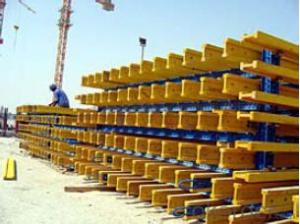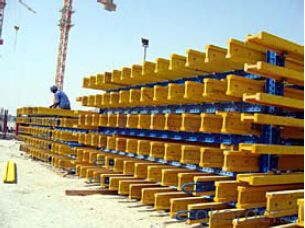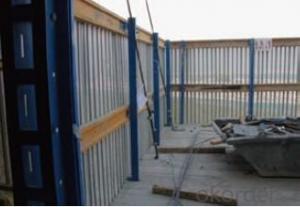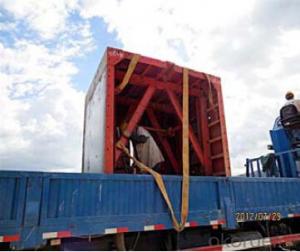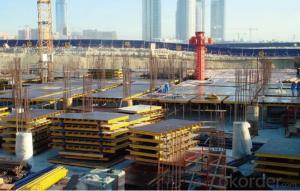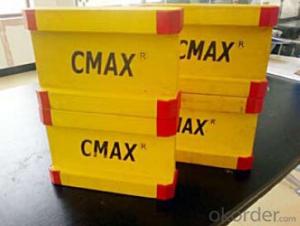Timber-Beam plywood Formwork for Building Construction
- Loading Port:
- Tianjin
- Payment Terms:
- TT OR LC
- Min Order Qty:
- 50 m²
- Supply Capability:
- 1000 m²/month
OKorder Service Pledge
Quality Product, Order Online Tracking, Timely Delivery
OKorder Financial Service
Credit Rating, Credit Services, Credit Purchasing
You Might Also Like
Plywood --- make perfect concrete surface
WISA-Form Birch is a coated special plywood using in the formwork systems where high
requirements are set on the concrete surface and the times of reuses.
With CNBM timber beam & WISA plywood, the formwork is low weight but high load capacity, it is
widely used in construction.
Characteristics:
◆ Component with high standardization.
◆ Assembling in site, flexible application.
◆ Light weight, easy transportation and storage.
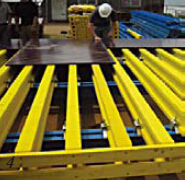
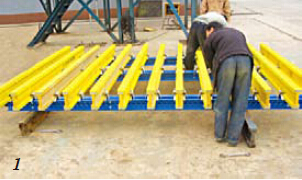
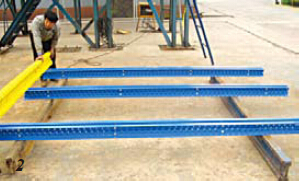
- Q: What are the different types of reinforcement systems used with steel formwork?
- There are several different types of reinforcement systems that are commonly used with steel formwork in construction projects. These systems are designed to provide additional strength and stability to the formwork, ensuring that it can withstand the weight of the concrete and other loads. One common type of reinforcement system is the use of steel bars or rods, also known as rebar. Rebar is typically placed horizontally and vertically within the formwork to create a grid-like structure. This helps to distribute the weight of the concrete evenly and prevent any potential cracks or failures in the formwork. Another type of reinforcement system is the use of wire mesh or welded wire fabric. This is a grid of wires that is typically laid over the formwork before the concrete is poured. The wire mesh helps to reinforce the concrete and provide additional strength and durability. In some cases, steel formwork may also incorporate precast concrete elements as reinforcement. These elements, such as precast beams or columns, are placed within the formwork to provide additional support and reinforcement to the structure. Additionally, some formwork systems may utilize post-tensioning techniques for reinforcement. This involves installing steel cables or bars within the formwork and then applying tension to them after the concrete has been poured. This helps to increase the strength and stability of the formwork and the overall structure. Overall, the choice of reinforcement system will depend on the specific requirements of the project, including the load capacity, design specifications, and desired level of durability. By using appropriate reinforcement systems, steel formwork can be made stronger and more reliable, ensuring the success and safety of the construction project.
- Q: How does steel formwork handle different concrete surface texture requirements?
- Steel formwork is a versatile and durable option for handling different concrete surface texture requirements. It is designed to be adjustable and customizable, allowing for various surface finishes to be achieved. One way steel formwork handles different concrete surface texture requirements is through its ability to be easily modified and adapted. Steel formwork panels can be adjusted to accommodate different surface finishes such as smooth, textured, or patterned concrete. This flexibility makes it suitable for a wide range of construction projects, from simple slabs to complex structures. Furthermore, steel formwork provides a smooth and consistent surface, which is crucial for achieving a desired concrete finish. The rigid and sturdy nature of steel ensures that the formwork remains in place during the pouring and curing process, preventing any distortions or imperfections from occurring. This results in a uniform surface texture, regardless of the complexity of the design. Additionally, steel formwork offers excellent resistance to wear and tear, making it suitable for projects that require repetitive use or high-volume concrete pouring. The durability of steel formwork allows it to maintain its shape and integrity even after multiple uses, ensuring consistent concrete surface texture requirements are met over time. In conclusion, steel formwork is a reliable and adaptable solution for handling different concrete surface texture requirements. Its adjustability, durability, and ability to provide a smooth and consistent surface make it an ideal choice for achieving various finishes, regardless of the complexity of the project.
- Q: Can steel formwork be used for precast concrete slabs?
- Yes, steel formwork can be used for precast concrete slabs. Steel formwork is a commonly used method for creating the molds or formwork for pouring concrete in precast construction. Steel formwork offers several advantages, including high durability, reusability, and superior strength compared to other types of formwork materials. It provides a rigid and stable structure that can withstand the weight and pressure of the concrete during the casting process. Steel formwork also allows for precise shaping and finishing of the concrete slabs, ensuring a high-quality and consistent end product. It can be easily assembled and disassembled, making it suitable for repetitive use in precast concrete production. Additionally, steel formwork can be designed and customized to meet specific project requirements, including different sizes, shapes, and patterns for the concrete slabs. However, it is important to consider the cost and maintenance of steel formwork, as it can be more expensive compared to other types of formwork materials such as wood or plastic. Regular maintenance and cleaning are necessary to ensure the longevity and efficiency of steel formwork. Overall, steel formwork is a reliable and widely used option for creating molds for precast concrete slabs, offering numerous benefits in terms of strength, durability, and customization options.
- Q: What are the different types of edge protections available for steel formwork?
- There are several types of edge protections available for steel formwork, each serving a specific purpose and providing different levels of safety and functionality. Some of the common types include: 1. Steel edge protection: This type of edge protection is made of steel and is typically used in heavy-duty construction projects. It provides excellent durability and strength, ensuring the safety of workers and preventing accidental falls. 2. Rubber edge protection: Rubber edge protection is a flexible and lightweight option that offers impact resistance and a cushioning effect. It is commonly used in areas where workers may come into contact with the edge, such as staircases or walkways. 3. Plastic edge protection: Plastic edge protection is lightweight, easy to install, and cost-effective. It provides a barrier between workers and the edge, preventing accidental slips or falls. Plastic edge protection is commonly used in low-risk areas or temporary construction sites. 4. Foam edge protection: Foam edge protection is made of soft and flexible material, providing a cushioning effect and preventing injury if someone accidentally bumps into it. It is typically used in areas where there is less risk of falls but a higher chance of impact. 5. Metal edge protection: Metal edge protection is commonly used in industrial settings where heavy machinery or equipment may come into contact with the edge. It offers excellent durability and protection against impact, ensuring the safety of both workers and equipment. 6. Removable edge protection: This type of edge protection can be easily installed and removed when no longer needed. It is commonly used in areas where temporary edge protection is required, such as during construction or renovation projects. It is essential to choose the appropriate type of edge protection based on the specific requirements of the construction project, considering factors such as the level of risk, durability, ease of installation, and cost-effectiveness.
- Q: Concrete, reinforcing steel for the labor price? 18 storey elevator apartment with a layer of underground carpentry, concrete, steel artificial price. (to the workers to do the Contractor) the problem added: steel, including the production and installation of a full set of artificial ha, concrete is mixed business. Template carpenter??? Concrete with nails??? Steel??? Including machine...Is the area of 10000 square meters of construction area template?How many tons of steel?
- The main body of the wall and inside and outside the powder to the construction area of 70/M2 (including small equipment)10000 square meters of construction area by the consideration of the template to pay two, the need for a template of 10000 square metersThere are about 6~700 tons of rebar
- Q: How does steel formwork affect the overall thermal performance of the building?
- Steel formwork does not directly affect the overall thermal performance of the building as it is primarily used in the construction process for shaping and supporting concrete structures. However, if steel formwork is not properly insulated or if there are gaps between the formwork and the concrete, it can contribute to thermal bridging, which can negatively impact the building's energy efficiency.
- Q: What are the considerations when designing steel formwork for slabs with openings?
- When designing steel formwork for slabs with openings, several important considerations need to be taken into account. These include: 1. Load-bearing capacity: The formwork must be able to support the weight of the concrete, as well as any additional loads that may be placed on it during construction or use. The formwork should be designed to withstand these loads without experiencing excessive deflection or failure. 2. Durability: Steel formwork should be designed to withstand the harsh conditions of construction sites, including exposure to moisture, chemicals, and physical impact. The material chosen should be resistant to corrosion and have a high strength-to-weight ratio. 3. Flexibility and adjustability: Since slabs with openings often have irregular shapes and sizes, the formwork should be designed to be flexible and adjustable. This allows for easy customization and ensures a precise fit for the openings. 4. Support for reinforcement: The formwork should provide adequate support for the reinforcement bars or mesh used within the slab. It should be designed to accommodate the placement and spacing of these reinforcements, ensuring proper concrete cover and structural integrity. 5. Ease of assembly and disassembly: The formwork system should be designed for easy assembly and disassembly, as it needs to be repeatedly used for multiple slabs with openings. The components should be lightweight and easily maneuverable, allowing for efficient construction and reduced labor costs. 6. Safety: Safety is of utmost importance in the design of steel formwork. The formwork should be designed to prevent accidents, such as slipping or collapsing, during assembly, concrete pouring, and removal. Adequate safety measures, such as guardrails and non-slip surfaces, should be incorporated into the design. 7. Cost-effectiveness: The design should aim to minimize material and labor costs while still ensuring the required strength and durability. Efficient use of materials and standardization of components can help reduce overall costs. 8. Compatibility with other construction systems: The formwork should be compatible with other construction systems, such as scaffolding or shoring, to ensure proper integration and coordination during the construction process. By considering these factors, designers can create steel formwork systems that are safe, durable, cost-effective, and efficient for slabs with openings.
- Q: Can steel formwork be used in tunnel construction?
- Yes, steel formwork can be used in tunnel construction. It is a durable and strong material that can withstand the pressure and weight of the soil and concrete in tunnel construction. Its versatility allows it to be easily customized and assembled to match the shape and size of the tunnel, making it an ideal choice for this type of construction project.
- Q: Can steel formwork be used for water retaining structures?
- Yes, steel formwork can be used for water retaining structures. Steel formwork is known for its strength, durability, and ability to withstand high pressures. When properly designed and constructed, steel formwork can provide a watertight seal and effectively resist the hydrostatic pressure exerted by water. Additionally, steel formwork allows for a smooth and uniform finish, reducing the risk of water leakage. However, it is essential to ensure proper waterproofing measures are in place, such as using appropriate sealing materials and techniques, to prevent any potential water leakage or seepage through joints or connections. Regular inspection and maintenance are also necessary to ensure the long-term integrity of the water retaining structure.
- Q: How does steel formwork prevent concrete spillage?
- To prevent concrete spillage, steel formwork is utilized as it provides a sturdy and inflexible framework. This framework effectively contains and secures the concrete in position throughout the pouring and curing stages. To ensure that the concrete does not escape, the steel formwork is meticulously designed with seamless joints and a smooth surface, leaving no room for gaps or leaks. Consequently, any potential spillage or leakage during the pouring process is avoided. Furthermore, the strength and stability of steel formwork are often enhanced by incorporating internal bracing or supports. This reinforcement fortifies the formwork, preventing any movement or distortion, and ensuring it maintains its intended shape and position. Consequently, the steel structure acts as a barrier, preventing the concrete from spilling or overflowing. In addition, steel formwork is typically constructed with securely connected vertical sides and bottom plates. This specific configuration establishes an effective containment system that securely holds the concrete in place, preventing it from flowing out or penetrating any crevices. The snug fit of the formwork also aids in achieving the desired shape and dimensions of the cast concrete structure. In conclusion, steel formwork is a dependable and sturdy solution to prevent concrete spillage. Its strength, rigidity, and seamless joints guarantee that the concrete is contained within the desired area, significantly minimizing the risk of spillage or leakage during the construction process.
Send your message to us
Timber-Beam plywood Formwork for Building Construction
- Loading Port:
- Tianjin
- Payment Terms:
- TT OR LC
- Min Order Qty:
- 50 m²
- Supply Capability:
- 1000 m²/month
OKorder Service Pledge
Quality Product, Order Online Tracking, Timely Delivery
OKorder Financial Service
Credit Rating, Credit Services, Credit Purchasing
Similar products
Hot products
Hot Searches
Related keywords

